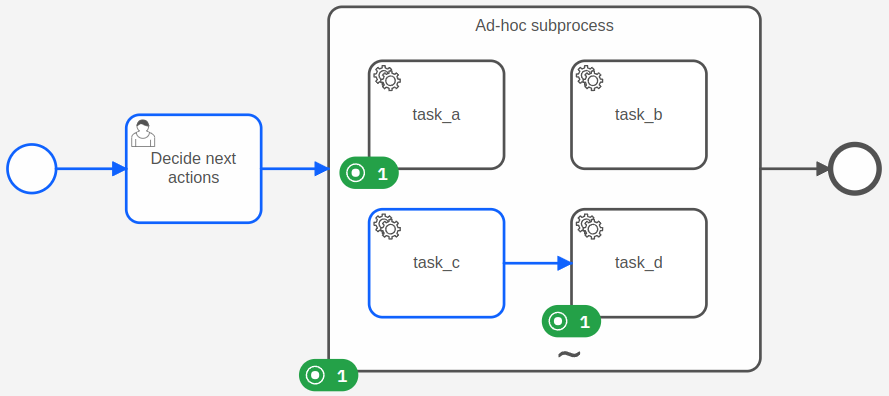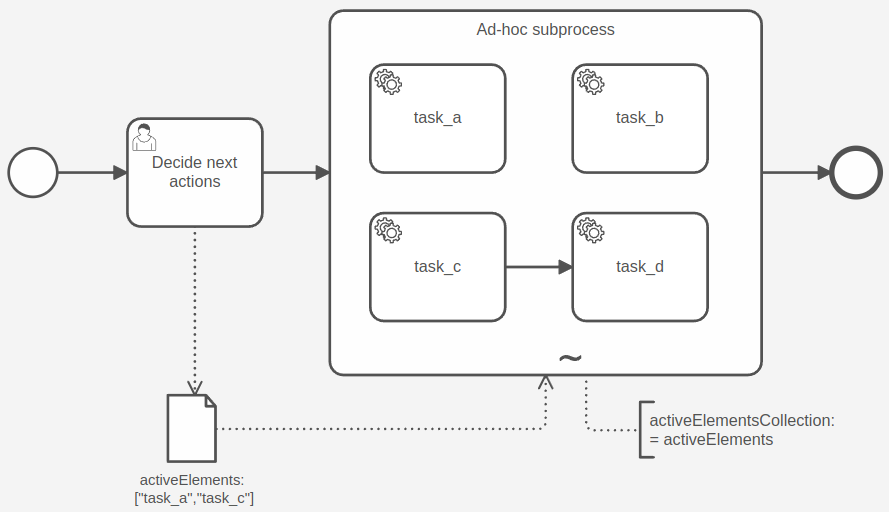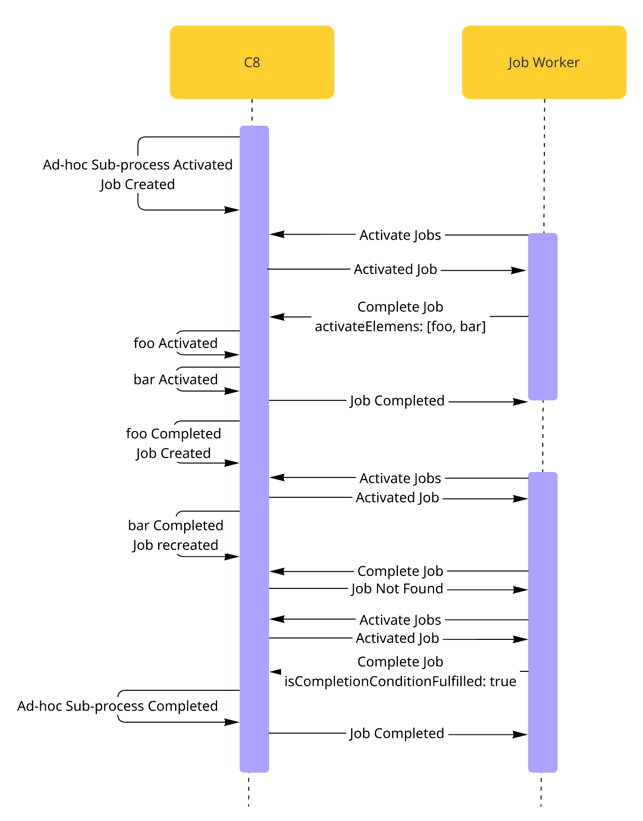Ad-hoc sub-processes
Ad-hoc sub-processes are a special kind of embedded subprocesses with an ad-hoc marker (represented by a ~ tilde character). Compared to regular subprocesses, ad-hoc sub-processes allow more flexibility for executing inner elements.

The inner elements of an ad-hoc sub-process are not connected to a start or end event. Each element can be executed multiple times, in any order, or skipped.
If elements depend on each other, the elements can be connected by a sequence flow to build a structured sequence within the ad-hoc sub-process.
An ad-hoc sub-process can be handled internally by Zeebe, or by using a job worker.
Constraints
An ad-hoc sub-process has the following constraints:
- Must have at least one activity
- Must not have start events or end events
BPMN implementation
By default, ad-hoc sub-processes are handled internally in Zeebe. You can model which elements to activate and when the sub-process is completed. Alternatively, use the ad-hoc sub-process API to activate elements manually.
Activate an element
An ad-hoc sub-process can define an expression activeElementsCollection that should return a
list of strings. Each string in the list should match to an ID of
an inner element of the ad-hoc sub-process. Usually, the expression accesses a process variable that was
created before and holds the list of element IDs.

When a process instance reaches an ad-hoc sub-process, it evaluates the expression activeElementsCollection and
activates all elements whose element IDs are in the list.
If the list is empty or the expression is not defined, no element is activated and the ad-hoc sub-process remains active.
If the expression doesn't evaluate to a list of strings, or the list contains other values than inner element IDs, the process instance creates an incident.
Currently, it is not possible to activate elements dynamically after the ad-hoc sub-process is activated, only on entering the subprocess.
Completion
An ad-hoc sub-process can define an optional completionCondition boolean expression
that is evaluated every time an inner element is completed.
- If the expression evaluates to
trueafter completing an inner element, the ad-hoc sub-process is completed and the process instance takes the outgoing sequence flows. - If no
completionConditionis defined, the ad-hoc sub-process is completed after all activated elements are completed.
A cancelRemainingInstances boolean attribute can be configured to influence the ad-hoc sub-process behavior when the completion condition is met.
- If set to
true(default value), all remaining active instances of inner elements are terminated and the ad-hoc sub-process is directly completed. - If set to
false, the ad-hoc sub-process waits for the completion of all active instances before completing.
Job worker implementation
You can handle an ad-hoc sub-process using a job worker. To do this, define the sub-process with a task definition. The job worker can then control the sub-process by activating inner elements and deciding when it completes.
When an ad-hoc sub-process is defined as a job worker, it creates a job upon activation. The worker must decide what the next step is.
It can use the adHocSubProcessElements variable (see special ad-hoc sub-process variables) to determine available elements.
When a process instance reaches an ad-hoc sub-process with a job worker implementation:

- Zeebe creates a corresponding job and waits for its completion.
- The job worker decides which elements to activate and completes the job with an
adHocSubProcessjob result. - Zeebe activates the elements from the job result.
- When any of the flows inside the ad-hoc sub-process completes, Zeebe creates a new job for the ad-hoc sub-process.
- The job worker decides the next step. It can activate more elements or fulfill the completion condition. If the condition is fulfilled, the job worker can specify whether to cancel active elements. It cannot fulfill both the completion condition and activate new elements at the same time.
Because a worker can activate multiple elements at once, and Zeebe creates a job whenever one completes, the job for the ad-hoc sub-process may be recreated during execution. There is only one active job for the ad-hoc sub-process at a time. The job worker should expect that:
- A job may be recreated while it is still processing.
- Job completion may result in a
NOT_FOUNDrejection.
Collect output
You can collect the output of inner flows in an ad-hoc sub-process by defining the outputCollection and outputElement expressions.
-
outputCollectiondefines the variable name that stores the collected output (for example,results). This variable is created as a local variable of the ad-hoc sub-process and updated whenever an inner flow completes. When the ad-hoc sub-process completes, theoutputCollectionvariable is propagated to the parent scope. -
outputElementdefines the output of the inner flow (for example,= result). This expression usually accesses a variable of the inner flow that holds the output value. This variable should be created with the output value, for example, by a job worker providing a variable with the nameresult.
When an inner flow completes, the outputElement expression is evaluated and the result is added to the outputCollection.
Special ad-hoc sub-process variables
When an ad-hoc sub-process is activated, the adHocSubProcessElements variable is created in its scope.
This variable provides metadata about the sub-process and its inner elements. Job workers can use it to decide which elements to activate.
The variable contains a list of activatable elements. Each element includes:
elementId: The ID of the element.elementName: The name of the element.documentation: The documentation of the element.properties: The properties defined on the element.parameters: Parameters defined using thefromAiFEEL function.
Do not update the adHocSubProcessElements variable. Changing its value can cause unexpected behavior.
Variable mappings
An ad-hoc sub-process can define input and output variable mappings.
Input variable mappings are applied on activating the ad-hoc sub-process and before evaluating the expression
activeElementsCollection. They can be used to create local variables for the ad-hoc sub-process.
Output variable mappings are applied on completing the ad-hoc sub-process. They can be used to propagate local variables from the ad-hoc sub-process into the process instance. By default, no local variables are propagated.
Additional resources
XML representation
<bpmn:adHocSubProcess id="ad-hoc-subprocess" name="Ad-hoc sub-process" cancelRemainingInstances="false">
<bpmn:extensionElements>
<zeebe:adHoc activeElementsCollection="=activeElements" />
</bpmn:extensionElements>
... more contained elements ...
<bpmn:completionCondition xsi:type="bpmn:tFormalExpression">=myCondition</bpmn:completionCondition>
</bpmn:adHocSubProcess>